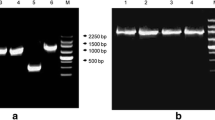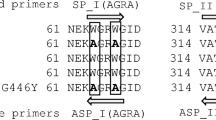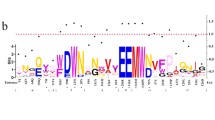Abstract
The endoglucanase, EGA, from Bacillus sp. AC-1 comprises a glycosyl hydrolase family-9 catalytic module (CM9) and a family-3 carbohydrate-binding module (CBM3). Seven aromatic residues were subjected to site-directed mutagenesis in both CBM3 and EGA to investigate their roles in enzyme thermostability. The complexes generated by mixing CBMY527G, CBMW532A, or CBMF592G with CM9 each lost their activities after 15 min at 45°C, while the wild-type complex retained >70% activity after 2 h. The mutants EGAY527G, EGAW532A, and EGAF592G showed little activity after 15 min at 60°C, whereas EGA remained 70% active after 2 h. Thus the residues Tyr527, Trp532, and Phe592 contribute not only to CBM3-mediated stability of CM9 but also to EGA thermostability suggesting that hydrophobic interaction between the two modules, independent of covalent linkages, is important for enzyme thermostability.
Similar content being viewed by others
Avoid common mistakes on your manuscript.
Introduction
Most cellulases consist of at least one catalytic module (CM) and a carbohydrate-binding module (CBM) (Rabinovich et al. 2002). CBMs are responsible for attaching enzymes to insoluble polysaccharide surfaces, thereby increasing the local enzyme concentration (Simpson et al. 2000), whereas CMs perform hydrolysis of substrates. Many cellulase CMs and CBMs have been expressed and analysed as isolated modules (Nakazawa et al. 2008; Ziegelhoffer et al. 2009) and indicate that these modules can function independently. However, the omission of CBM from cellulase can affect enzyme stability. For example, the deletion of CBM from Ampullaria crossean cellulase EGX decreased enzyme thermostability (Ding et al. 2008), and the removal of the family IIIc cellulose binding domain (CBD) from Clostridium stercorarium cellulase CelZ also adversely affected enzyme thermostability (Arai et al. 2003). The mechanism by which CBM alters cellulase thermostability has not been studied in detail.
Aromatic amino acid residues in CBMs play important roles in binding polysaccharides through the formation of hydrophobic stacking interactions with the non-polar sugar rings of substrates (Hilden and Johansson 2004; Hashimoto 2006). However, whether those aromatic residues take part in maintaining the thermostability or activity of the enzyme remains unknown.
In a previous study, we found that a novel endoglucanase, EGA, from Bacillus sp. AC-1 comprises a glycosyl hydrolase family-9 catalytic module (CM9) and a family-3 carbohydrate-binding module (CBM3). The isolated CBM3 enhanced the thermostability of CM9, reflecting molecular interactions independent of covalent linkage (Zhang et al. 2007). In the present study, seven aromatic amino acids were mutated in both CBM3 and EGA to investigate the relative importance of these residues in CBM3-mediated CM9 thermostability. The enzyme thermostabilities were monitored on the basis of the inactivation time at a particular temperature. The results revealed that Tyr527, Trp532, Phe542, and Phe592 are central to maintaining hydrophobic interactions between the modules, thereby contributing to enzyme thermostability.
Materials and methods
Reagents
Carboxymethylcellulose (CMC-Na), PMSF and oat-spelt xylan were purchased from Sigma (USA). IPTG was from Sanland-Chem (USA). DpnІ was purchased from New England Biolabs (USA), and PrimeSTAR HS DNA polymerase was from Takara (Japan). The other chemicals used were reagent grade from Shanghai Chemical Industries (China).
Construction of CBM3 and EGA mutants
The plasmids pET-28a_CBM3 and pET-28a_EGA, constructed as previously described (Zhang et al. 2007), served as templates for all PCRs. The amino acid residues of interest were individually changed to alanine or glycine using the oligonucleotide primers listed in Supplementary Table 1. All PCRs were performed with a PrimeSTAR polymerase kit (Takara). After PCR, DpnI was added to each 50 μl PCR mixture and incubated at 37°C for 1 h. Each resulting plasmid was transformed into E. coli Top10, amplified and sequenced.
Expression and purification of mutated proteins
Escherichia coli BL21 (DE3) harbouring the recombinant plasmid was cultured in LB medium containing 30 μg kanamycin/ml at 37°C until the OD600 reached 0.8. Protein expression was induced at 16°C by adding IPTG at 1 mM for 20 h. Bacteria were harvested by centrifugation at 10,000×g for 10 min at 4°C. The pellets were resuspended in buffer containing 20 mM Tris/HCl (pH 8.0), 500 mM NaCl, 5% (v/v) glycerol and 0.5 mM PMSF, sonicated (UP200H cell disruptor, Heilscher, Germany) for 30 min in an ice bath and then centrifuged at 12,000×g for 30 min at 4°C to remove cell debris. The protein was purified from the supernatant using HisTrap HP (Qiagen) in accordance with the manufacturer’s protocols and then dialysed against 20 mM sodium phosphate buffer (pH 6.5).
Binding assays
Binding isotherms were performed as described with a few modifications (Bolam et al. 2001). The free protein concentration (μM) in the supernatant was determined by the Lowry method. The bound polypeptide concentration (μmol/g of substrate) was calculated from the concentration of total protein minus free protein. The data were analysed by nonlinear regression using a one-site binding model (GraphPad Prism). To determine the relative equilibrium association constant K r (l/g), we used the method described by Gilkes et al. (1992). This enabled comparison of the affinities of various related ligands for a given preparation of polysaccharide.
Enzyme assay
The enzyme reaction mixture contained the appropriate enzymes and 100 μl 1% CMC-Na (1%, w/v in sodium phosphate buffer, pH 6.5). The reactions were carried out at 50°C for 10 min and were terminated by adding 0.25 ml DNS and then heating the mixture in a boiling water bath for 6 min. After adding 0.25 ml H2O, the absorbance was measured at 540 nm (Miller 1959). One unit of enzyme is defined as the amount of enzyme that catalyses formation of 1 μmol glucose per min under the assay conditions.
Effects of temperature and pH on enzyme activity and thermostability
In a previous study, asEGA represents a complex generated by mixing the purified CM9 and CBM3 at 4°C in a 1:1 ratio of (Zhang et al. 2007). Here, each CBM3 mutant was mixed with CM9 to generate mutated asEGA. To analyse the properties of asEGA and its mutants, reactions were carried out at 35°C, while 50°C was used for EGA and its mutants. The optimal reaction pH was assessed with buffers containing potassium phosphate, citric acid, barbitone, boric acid, and NaOH with pH values ranging from 3.0 to 12.5. The stability of pH in the assay buffers was monitored at 4°C for 2 h. The optimal reaction temperature was evaluated over the range of 30–80°C in 20 mM sodium phosphate buffer (pH 6.5). The thermostability of the mutated asEGA complexes was tested by incubating the enzyme at 45°C for various intervals (0–120 min), whereas the mutated EGA complexes were incubated at 60 and 50°C also at various intervals (0–120 min).
Results
Generation of mutants of CBM3 and EGA
Nine aromatic amino acid residues in CBM3, namely, Tyr527, Trp532, Phe542, Tyr544, Tyr545, Tyr 579, Tyr 586, Phe587 and Phe592, were subjected to site-directed mutagenesis to investigate their functions. Sequence analysis of CBM3 indicated that eight of these residues were conserved in family-3 CBMs (Fig. 1). Each of these nine residues was substituted with alanine or glycine. The mutants CBMY544G and CBMY545G were expressed as inclusion bodies in E. coli BL21 (DE3), reducing the number of CBM3 mutants available for analysis to seven. These seven mutants were CBMY527G, CBMW532A, CBMF542G, CBMY579G, CBMY586G, CBMF587G, and CBMF592G. The same residues were mutated in EGA, providing the following seven mutants: EGAY527G, EGAW532A, EGAF542G, EGAY579G, EGAY586G, EGAF587G, and EGAF592G. All the mutant proteins were expressed in E. coli BL21 (DE3) in soluble form and were purified using one-step chelation chromatography to apparent homogeneity, as judged by SDS-PAGE (Fig. 2).
SDS-PAGE analyses of the purified mutated proteins. a SDS-PAGE of the CBM3 mutants. Lane 1, CBM3; lane 2, CBMY527G; lane 3, CBMW532A; lane 4, CBMF542G; lane 5, CBMY579G; lane 6, CBMY586G; lane 7, CBMF587G; lane 8, CBMF592G. b SDS-PAGE of the EGA mutants. Lane 1, EGA; lane 2, EGAY527G; lane 3, EGAW532A; lane 4, EGAF542G; lane 5, EGAY579G; lane 6, EGAY586G; lane 7, EGAF587G; lane 8, EGAF592G. M, molecular mass standards 97.4, 66.2, 43.0, 31.0, 20.1, 14.4 kDa
Affinities of CBM3 and its mutants for insoluble xylan
Binding-isotherm measurements were performed to determine the affinities of CBM3 and its mutants for the insoluble oat-spelt xylan. K r, the relative equilibrium constant (l/g), was determined as a measure of the relative affinities between different proteins and the substrate (Gilkes et al. 1992). The affinities of CBM3 and its mutants for this substrate were analysed, with the results shown in Table 1. The K r values of CBMY527G, CBMW532A, CBMF542G, and CBMF592G were lower than that of the wild-type CBM, which indicates that these mutants had lower affinities for insoluble xylan, with CBMW532A showing the lowest affinity among the seven mutants.
Enzymatic properties of the asEGA mutants
The seven CBM3 mutants were mixed with CM9 of EGA to generate seven asEGA mutant complexes, which were asEGAY527G, asEGAW532A, asEGAF542G, asEGAY579G, asEGAY586G, asEGAF587G, and asEGAF592G. The effects of temperature and pH on these mutants were analysed. All complexes had similar optimal pH values (Table 2) and pH stability profiles (Fig. 3a), but asEGAW532A, asEGAF592G, and asEGAY527G exhibited much lower optimal reaction temperatures than that of wild-type asEGA (Table 2). The thermostability assays were performed by incubating the seven asEGA mutants at 45°C for various the wild-type asEGA and CM9 serving as two controls (Fig. 3b).
Effects of pH and temperature on the stabilities of the asEGA mutants. a Effects of pH on the stabilities of the complexes. The complexes were incubated at different pH conditions at 4°C for 2 h, and their residual activities were assayed at 35°C. b Effects of temperature on the stabilities of the complexes. Thermostability experiments were performed by incubating the complexes at 45°C for different times (from 0 to 120 min). Residual activity was assessed at 35°C. The wild-type asEGA and CM9 served as controls
The mutants, asEGAY527G asEGAW532A, and asEGAF592G and CM9 had extremely low thermostabilities: almost all activity was lost after 15 min. On the other hand, asEGAF542G retained approx. 50% activity under the same conditions. However, when the incubation time was extended to 60 min, asEGAF542G retained only 10% activity.
Enzymatic properties of the EGA mutants
The optimal reaction temperatures of EGAW532A and EGAF592G were much lower than that of wild-type EGA, while those of EGAY527G, EGAF542G, and EGAF587G were slightly lower than that of wild-type EGA (Table 3).
The thermostability assays were performed by incubating the seven EGA mutants at 60°C for various intervals, and wild-type EGA served as a control (Fig. 4b). EGAW532A and EGAF592G lost all activity after incubation for 15 min, and EGAY527G was inactive after 30 min. When the incubation time was extended to 120 min, EGAF542G lost its activity, while the wild-type EGA remained approximately 60% active. Another thermostability assay, performed at 50°C, showed that after 2 h, EGAW527A was completely inactive whereas EGAF592G retained more than >80% activity. EGAW527A had the lowest thermostability among the seven mutants (Fig. 4c).
Effects of pH and temperature on the stabilities of the EGA mutants. a Effects of pH on the stabilities of the EGA mutants. The enzymes were incubated at different pH conditions at 4°C for 2 h, and their residual activities were assayed at 50°C. b Effects of temperature on the stabilities of the EGA mutants. Thermostability experiments were performed by incubating the enzymes at 60°C for different times (from 0 to 120 min). Residual activity was assessed at 50°C. c Effects of temperature on the stabilities of EGAW532A and EGAF592G. Thermostability experiments were performed by incubating the two proteins at 50°C for various times (from 0 to 120 min). Residual activity was assessed at 50°C. The wild-type EGA served as a control
The specific activities of the seven mutants towards CMC (1%, w/v) are shown in Table 3. EGAW532A had the lowest specific activity, which was 50% lower than that of EGA, whereas those of EGAY527G, EGAF542G and EGAF592G were approx. 20% lower than that of EGA. Mutations of Tyr579, Tyr586, and Phe587 had little effect on either the thermostability or the specific activity of EGA.
Discussion
The binding of CBMs to polysaccharides is mediated primarily by hydrophobic stacking interactions between sugar pyranose rings and aromatic amino acids (Shoseyov et al. 2006). In this study, Tyr527, Trp532, Phe542, and Phe592 in CBM3 were found to play roles in binding to insoluble substrates; this role is exemplified by the Trp532Ala substitution, which caused a significant decrease in xylan binding affinity. The mutant CBMW532A thus had the weakest hydrophobic interactions with the sugar pyranose rings among the four mutants. Enzyme activity assays of the asEGA mutants also revealed that, compared to the wild-type CBM3, the CBMY527G, CBMW532A, CBMF542G, and CBM592G mutants had almost no ability to enhance CM9 stability. These results suggest a potentially important role for these four aromatic residues in maintaining hydrophobic interactions between the modules to stabilise CM9. By using the three-dimensional structure of chain A of Thermomonospora-derived exocellulase (1JS4_A) as a template, the hypothetical conformation of CBM3 was predicted by the Swiss-Model (Schwede et al. 2003) (Fig. 5). The two amino acids Tyr527 and Trp532 are exposed to solvent, and their aromatic rings may interact with the CM9 module through hydrophobic interactions. Phe542 and Phe592 are located on the inside of the protein, and their aromatic rings may interact with each other to maintain the stability of CBM3. These potential interactions might be the reason why substitution of these four aromatic amino acids leads to significant declines in the thermostability of the complex.
Mutations of the seven aromatic amino acid residues in the full-length EGA endoglucanase were also performed to evaluate their effects on enzyme thermostability and activity. The mutants EGAY527G, EGAF542G, EGAF592G, and especially EGAW532A showed significantly lower stabilities as compared to that of wild-type EGA. Mutations of the same four residues caused decreased thermostabilities for the asEGA complex and for the full-length EGA enzyme. These results indicate the importance of these four aromatic residues in maintaining hydrophobic interactions between the two modules, and this interaction, independent of covalent linkage, is necessary for normal enzyme thermostability.
We document here for the first time the importance of aromatic residues in CBM on enzyme thermostability, and these results may provide new directions for the protein engineering of cellulases, with the intent of improving their stability for industrial applications.
References
Arai T, Araki R, Tanaka A, Karita S, Kimura T, Sakka K, Ohmiya K (2003) Characterization of a cellulase containing a family 30 carbohydrate-binding module (CBM) derived from Clostridium thermocellum CelJ: importance of the CBM to cellulose hydrolysis. J Bacteriol 185:504–512
Bolam DN, Xie H, White P, Simpson PJ, Hancock SM, Williamson MP, Gilbert HJ (2001) Evidence for synergy between family 2b carbohydrate binding modules in Cellulomonas fimi xylanase 11A. Biochemistry 40:2468–2477
Ding M, Teng Y, Yin Q, Zhao J, Zhao F (2008) The N-terminal cellulose-binding domain of EGXA increases thermal stability of xylanase and changes its specific activities on different substrates. Acta Biochim Biophys Sin (Shanghai) 40:949–954
Gilkes NR, Jervis E, Henrissat B, Tekant B, Miller RC Jr, Warren RA, Kilburn DG (1992) The adsorption of a bacterial cellulase and its two isolated domains to crystalline cellulose. J Biol Chem 267:6743–6749
Guex N, Peitsch MC (1997) SWISS-MODEL and the Swiss-Pdb Viewer: An environment for comparative protein modeling. Electrophoresis 18:2714–2723
Hashimoto H (2006) Recent structural studies of carbohydrate-binding modules. Cell Mol Life Sci 63:2954–2967
Hilden L, Johansson G (2004) Recent developments on cellulases and carbohydrate-binding modules with cellulose affinity. Biotechnol Lett 26:1683–1693
Miller GL (1959) Use of dinitrosalicylic acid reagent for determination of reducing sugar. Anal Chem 31:426–428
Nakazawa H, Okada K, Kobayashi R, Kubota T, Onodera T, Ochiai N, Omata N, Ogasawara W, Okada H, Morikawa Y (2008) Characterization of the catalytic domains of Trichoderma reesei endoglucanase I, II, and III, expressed in Escherichia coli. Appl Microbiol Biotechnol 81:681–689
Rabinovich ML, Melnick MS, Bolobova AV (2002) The structure and mechanism of action of cellulolytic enzymes. Biochemistry (Mosc) 67:850–871
Schwede T, Kopp J, Guex N, Peitsch MC (2003) SWISS-MODEL: an automated protein homology-modeling server. Nucleic Acids Res 31:3381–3385
Shoseyov O, Shani Z, Levy I (2006) Carbohydrate binding modules: biochemical properties and novel applications. Microbiol Mol Biol Rev 70:283–295
Simpson PJ, Xie H, Bolam DN, Gilbert HJ, Williamson MP (2000) The structural basis for the ligand specificity of family 2 carbohydrate-binding modules. J Biol Chem 275:41137–41142
Zhang S, Yin QY, Li YH, Ding M, Xu GJ, Zhao FK (2007) Molecular and biochemical characterization of Ba-EGA, a cellulase secreted by Bacillus sp. AC-1 from Ampullaria crosseans. Appl Microbiol Biotechnol 75:1327–1334
Ziegelhoffer T, Raasch JA, Austin-Phillips S (2009) Expression of Acidothermus cellulolyticus E1 endo-beta-1, 4-glucanase catalytic domain in transplastomic tobacco. Plant Biotechnol J 7:527–536
Acknowledgments
This work was supported by the grants from the National Natural Science Foundation of China (No. 30370336), the Major State Basic Research Development Program of China (No. 2003CB716006 and No. 2004CB719702) and the Creation Foundation from Shanghai Institutes for Life Sciences.
Author information
Authors and Affiliations
Corresponding author
Electronic supplementary material
Below is the link to the electronic supplementary material.
Rights and permissions
About this article
Cite this article
Yin, Q., Teng, Y., Ding, M. et al. Site-directed mutagenesis of aromatic residues in the carbohydrate-binding module of Bacillus endoglucanase EGA decreases enzyme thermostability. Biotechnol Lett 33, 2209–2216 (2011). https://doi.org/10.1007/s10529-011-0680-y
Received:
Accepted:
Published:
Issue Date:
DOI: https://doi.org/10.1007/s10529-011-0680-y









